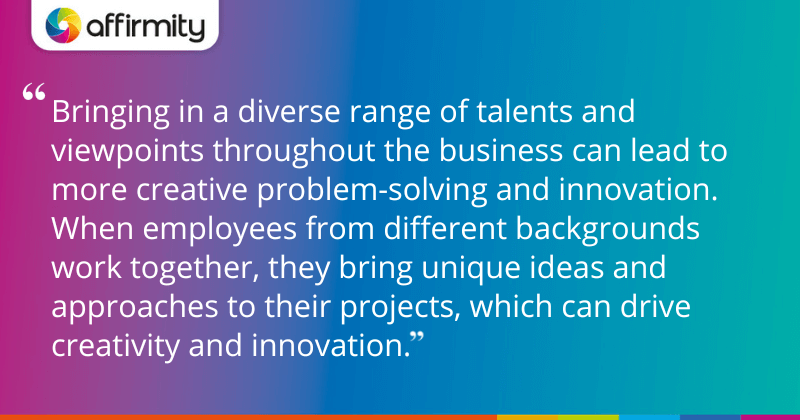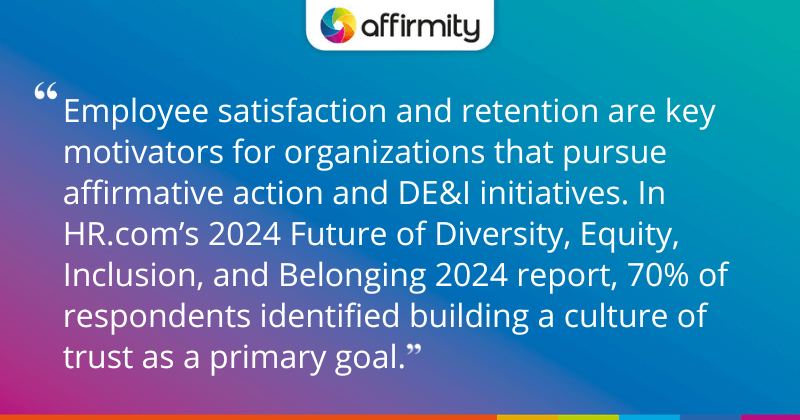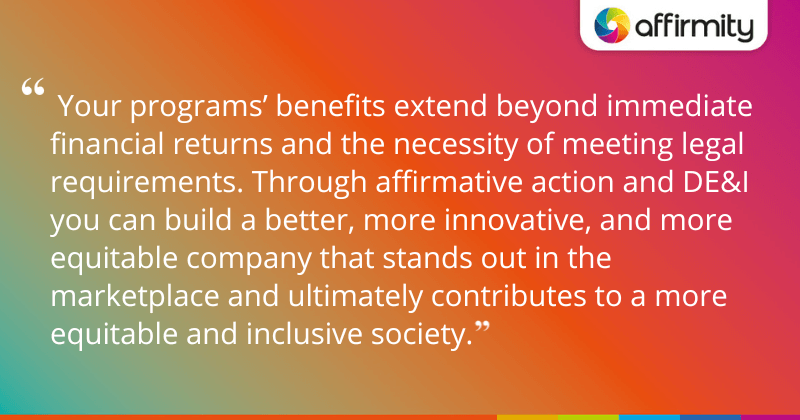The degree to which companies invest in their EEO, affirmative action, and DE&I programs varies widely. In this article, Kim Hendon, Affirmity’s Vice President of Sales, explores how, with a strategic approach, your investment can have a significant positive impact on your financial performance and organizational culture.
Over the years, we’ve seen the full spectrum of investment in affirmative action, EEO, and DE&I programs. Some organizations simply do the minimum required to maintain a comfortable, low level of risk. Others take a more proactive approach to their programs, and use it as a strategic tool that drives organizational success.
We’ll shortly examine the significant benefits gained with a strategic program. But first, it may help to review what “minimum” looks like.
Affirmative Action Law: What Threshold-Meeting Federal Contractors and Subcontractors Must Do
The laws around Affirmative Action in the workplace have remained largely unchanged for several decades:
- Executive Order 11246, requiring federal contractors and subcontractors to take affirmative action to ensure applicants and employees are treated fairly, has been in effect since 1965, when then-President Lyndon B. Johnson signed it into law.
- Title VII of the Civil Rights Act of 1964 additionally prohibits employment discrimination on the basis of race, color, religion, sex, and national origin.
- The Equal Employment Opportunity Commission’s guidelines on affirmative action were published in 1979. In the guidance, employers are encouraged to take voluntary steps to “correct the effects of past discrimination” and to prevent present and future discrimination. Suggested measures include expanding applicant pools to ensure a diverse body of applicants for any given position.
It’s naturally in an organization’s best interests to comply with Executive Order 11246, Title VII, and related laws such as Section 503 and VEVRAA to avoid potential fines, poor publicity, or loss of government contracts. It should be noted that between 2013 and 2023, the OFCCP secured over $246.7 million in monetary relief on behalf of employees and job seekers who were discriminated against. Additionally, the EEOC actively investigates claims that, in 2023 resulted in $440.5 million for 15,143 Victims of employment discrimination.
But why should an organization go beyond the basic requirements of these laws and the EEOC’s guidance? It’s easy to see these obligations as just “mandated by laws”. However, the truth is that this work can be the starting point for strategic initiatives that enhance your talent approach, improve your financial performance, and overhaul your image among candidates, employees, and customers.
Here are four reasons to make that investment.
GO BEYOND THE AFFIRMATIVE ACTION BASICS | ‘So, You’ve Completed Your Reports—What’s Next? The Pathway to Affirmative Action Program Success’

Reason #1: Enhanced Talent Pool
Companies known for their commitment to diversity and inclusion often attract a wider range of candidates, increasing the chances of hiring highly skilled and qualified individuals. In a 2023 Ernst & Young study, 63% of respondents across generations said they prioritize diversity, equity, and inclusiveness in choosing a company over one that does not.
This is similar to the findings of an earlier Glassdoor study in which 76% of job seekers and employees said that a diverse workforce was an important factor when evaluating job opportunities and companies.
Partnering with your talent acquisition teams helps you ensure your outreach is targeted and your candidate pools inclusive of the full market of individuals available to you. By ensuring that you include valid representation of historically underrepresented groups (such as females, minorities, individuals with disabilities, and protected veterans), you can enhance your talent pools, foster innovation and become a more attractive proposition to top talent.
Reason #2: Improved Financial Performance
Research has shown that diverse companies are better positioned to outperform their less diverse counterparts financially. For example, McKinsey & Company’s most recent diversity reporting found that companies in the top quartile for gender diversity on executive teams are 39% more likely to have above-average profitability than those in the fourth quartile. The same percentage difference was found in the case of ethnic and cultural diversity.
Additionally, Korn Ferry suggests that 80% of the organizations in its World’s Most Admired Companies list “purposely create inclusive and diverse teams to improve team performance and creativity”. Its research found that diverse and inclusive teams make better decisions 87% of the time. Similarly, a Boston Consulting Group study cited in Forbes found that companies with above-average diversity produced a greater proportion of revenue from innovation (45% of total) than from companies with below-average diversity (26%).
Bringing in a diverse range of talents and viewpoints throughout the business can lead to more creative problem-solving and innovation. Furthermore, diverse teams are often better at understanding and meeting the needs of a varied customer base. Simultaneously, when employees from different backgrounds work together, they bring unique ideas and approaches to their projects, which can drive creativity and innovation.
USE DATA TO DRIVE YOUR PROGRAMS | ‘Realistic DE&I Goal Setting: How to Use Data to Get Ahead’

Reason #3: Enhanced Employee Satisfaction and Retention
It logically follows that in addition to attracting top talent, a fair and inclusive workplace can improve employee satisfaction and retention. Organizations need whatever turnover-reduction tools they can get their hands on, considering the costs associated with hiring and training new employees—calculated to be around $4,700 per hire on average by SHRM. Broadly, your programs help to create:
- An Inclusive Environment: Employees are more likely to feel valued and engaged when you offer an inclusive work environment. This naturally leads to higher job satisfaction and lower turnover rates.
- A Reduction in Discrimination: Your affirmative action and DE&I efforts will increase employee and organizational vigilance against workplace discrimination and harassment, leading to a more harmonious working environment.
- Employee Morale and Team Cohesion: When employees see that their company values diversity, they experience a greater sense of belonging, leading to a more positive and productive work environment.
Employee satisfaction and retention are key motivators for organizations that pursue affirmative action and DE&I initiatives. In HR.com’s 2024 Future of Diversity, Equity, Inclusion, and Belonging 2024 report, 70% of respondents identified building a culture of trust as a primary goal, 60% cited being able to retain the right talent, and 58% cited boosting employee engagement.

Reason #4: Positive Brand Image
Organizations that actively promote diversity and inclusion can potentially enjoy a better public image, resulting in improvements to customer loyalty and brand reputation. An Ipsos Global Trends report found that, across 25 countries surveyed, an average 70% of respondents say they buy from brands they believe reflect their own principles. The goals of DE&I are agreed with by the majority of people—56% say focusing on increasing DE&I at work is mainly a good thing, and only 16% actually view this increase negatively.
Similarly, when 3,000 U.S. consumers from various backgrounds were interviewed about brand perception, 64% of those surveyed took action after seeing a diverse and inclusive ad, and people were overall more likely to purchase a product if they considered the ad diverse and inclusive.
Furthermore:
- A commitment to affirmative action and DE&I can be a significant market differentiator at a time when some competitors are reducing their commitments
- Investment in affirmative action and DE&I aligns with a wider commitment to ethical practices and social responsibility. It signals that your organization believes in creating fair opportunities and contributing to a more equitable society
GET THE LATEST INDUSTRY INSIGHTS | ‘10 Highlights From the National Industry Liaison Group Conference 2024’
Beyond the Studies: Proving Your Programs Work for You
While there’s no shortage of research pointing to these reasons to invest, no organization can be run solely on what’s successful for another. You must be able to measure whether the programs you run are working to advance affirmative action and DE&I as designed, and whether those programs are having a positive impact on the strategic factors mentioned above.
Some key areas of measurement include:
- Diversity benchmarking: As your programs evolve, you will want to measure changes in your workforce, including significant increases in the representation of historically underrepresented groups in key areas. This should be benchmarked against actual availability to ensure your goals are achievable. If your programs aren’t having the desired effect, this is naturally likely to undermine your ability to enjoy the benefits listed above.
- Retention rates: Measuring turnover and retention rates among diverse employees helps ensure that your programs are achieving results beyond initial onboarding. A wider view of retention among your whole employee population may also indicate how your program benefits your workplace culture in general.
- Employee engagement: Regular employee satisfaction surveys will help you gauge whether your people feel positively about your organizational goals, workplace, and culture. These surveys could include questioning specifically around awareness or perception of your programs.
- Customer engagement: Similarly, your organization may benefit from conducting external surveys in order to determine whether people view your brand positively.
Overall, it’s important to remember that your programs’ benefits extend beyond immediate financial returns and the necessity of meeting legal requirements. Through affirmative action and DE&I you can build a better, more innovative, and more equitable company that stands out in the marketplace and ultimately contributes to a more equitable and inclusive society.
If you’re ready to start transforming your investment and reap the rewards of an optimized program, learn more about Affirmity’s AAP assessment consulting services today. Contact us for more information.
About the Author
 Kim Hendon, Vice President of Sales, oversees account management and sales for Affirmity. She is responsible for building successful, long-term partnerships with clients for generating new business. Having served with the company for more than 20 years, Ms. Hendon has in-depth knowledge and broad experience in all areas of compliance and diversity.
Kim Hendon, Vice President of Sales, oversees account management and sales for Affirmity. She is responsible for building successful, long-term partnerships with clients for generating new business. Having served with the company for more than 20 years, Ms. Hendon has in-depth knowledge and broad experience in all areas of compliance and diversity.
Ms. Hendon assists clients with planning and development of affirmative action programs, diversity initiatives, and diversity training.
